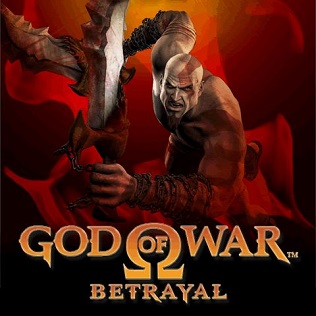
God of War: Betrayal
God of War: Betrayal is an action-adventure mobile game developed by Javaground and Sony Online Entertainment's (SOE) Los Angeles division, and published by Sony Pictures Digital. Released for mobile phones supporting the Java Platform, Micro Edition (Java ME) on June 20, 2007, it is the third installment in the God of War series, and the fifth chronologically. Loosely based on Greek mythology, Betrayal is set in ancient Greece with vengeance as its central motif. The player controls the protagonist Kratos, who became the new God of War after killing the former, Ares. Kratos is framed for the murder of Argos and pursues the true assassin across Greece, resulting in a confrontation with Olympian messenger Ceryx.
God of War: Betrayal
Philip Cohen
Philip Cohen
Philip Cohen, Nathan Leland, Alan Barasch[3]
Java Platform, Micro Edition (Java ME)
Betrayal is the only installment in the series to originally be released on a non-PlayStation platform and presented as a two-dimensional (2D) side-scrolling game. Despite the limitations of the mobile platform, in comparison to its home console counterparts, it retains the action-oriented approach of its predecessors, with the same combination of combo-based combat, platforming, and puzzle game elements. Although God of War is primarily a home console series, Betrayal was praised for its fidelity to the series in terms of gameplay, art style, and graphics: "the real deal third game in the killer franchise".[4] It received awards for "Wireless Game of the Month" (June 2007) and "Best Platform Game" (wireless) of 2007.
$_$_$DEEZ_NUTS#0__titleDEEZ_NUTS$_$_$
$_$_$DEEZ_NUTS#0__subtitleDEEZ_NUTS$_$_$
$_$_$DEEZ_NUTS#0__call_to_action.textDEEZ_NUTS$_$_$Development[edit]
God of War: Betrayal was announced by Sony Online Entertainment at a press conference in Los Angeles in May 2007. The game utilizes a total of 110 different animations and features a 2D rendition of the series' three dimensional (3D) graphics.[5][8] The character art and animation were done by WayForward Technologies, who were contracted by Javaground, who then revised and implemented it all. The only audio components are an orchestral score in the main menu and background sounds (e.g., clashing weapons).[9] In August 2007, Phil Cohen, producer, designer, and game director for Betrayal, spoke of the difficulties in developing a God of War game for a mobile device. Cohen said that although enjoyable, the greatest challenge was creating a single tileset and palette swapping scheme that was diverse enough to portray multiple environments with only several hundred kilobytes, and that met series creator Santa Monica Studio's high standards.[10] He wrote the initial design document between September and October 2005, and revisited it in August 2006, the month development started. The versions for high-end handsets were completed in April 2007, with final versions for low-end handsets completed by June 2007. The porting team adapted the game to over 200 handsets in a matter of weeks.[10]
Cohen stated that one challenge was capturing the feel of God of War's visual look and gameplay design, given the limited processing power and memory on most handsets at the time—complicating puzzle design, traps, environment interaction, and enemy behavior. He noted that both David Jaffe and Cory Barlog (game directors of God of War and God of War II, respectively) ensured the Betrayal development team captured the feel of the combat and visual style, and were "helpful with feedback and positive support". The team also worked closely with Eric Williams, the console game's lead combat designer. In keeping the "look and feel" true to the franchise, the development team played God of War extensively to study the pacing and tricks in the console releases.[10] The development team also worked closely with Marianne Krawczyk, the writer of the God of War console games. Krawczyk used Betrayal to bridge the events between God of War and God of War II, include additional backstory, and to explain why the relationship between the gods and Kratos had changed.[10]